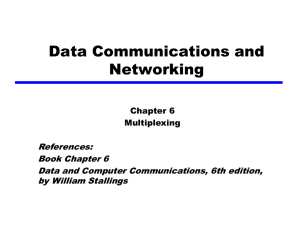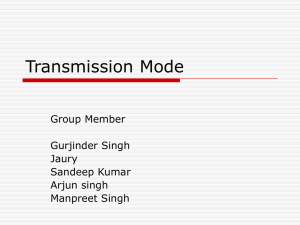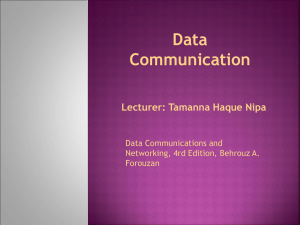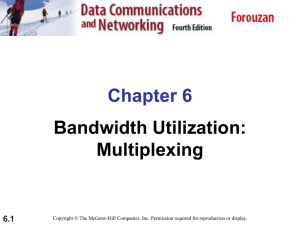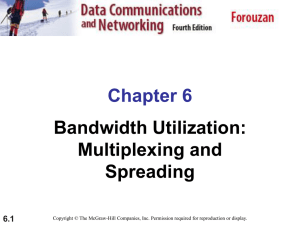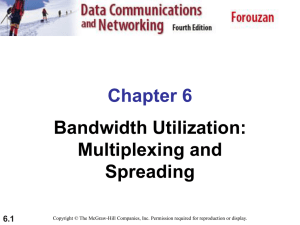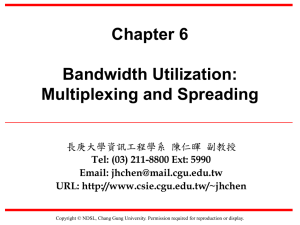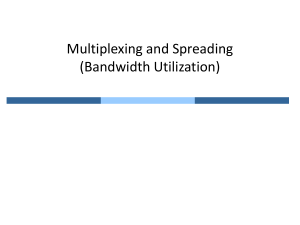the duration of each frame
advertisement
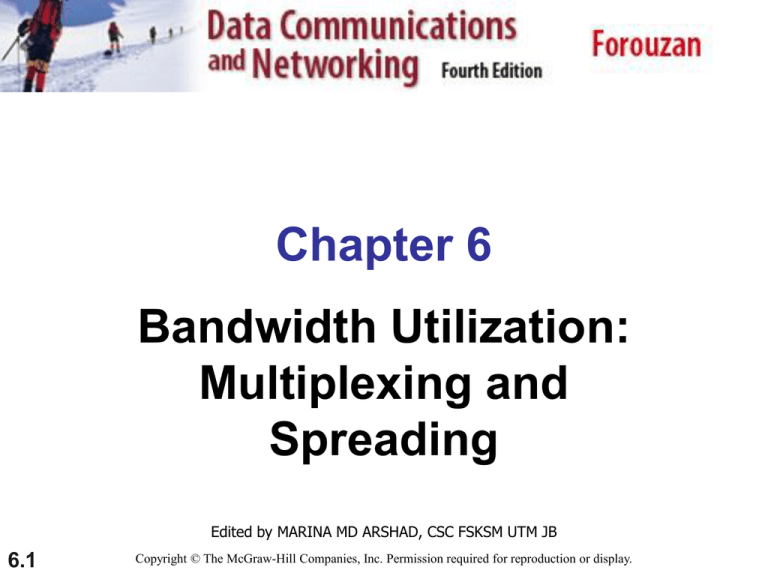
Chapter 6 Bandwidth Utilization: Multiplexing and Spreading Edited by MARINA MD ARSHAD, CSC FSKSM UTM JB 6.1 Copyright © The McGraw-Hill Companies, Inc. Permission required for reproduction or display. Note Bandwidth utilization is the wise use of available bandwidth to achieve specific goals. Efficiency can be achieved by multiplexing; privacy and anti-jamming can be achieved by spreading. 6.2 6-1 MULTIPLEXING Whenever the bandwidth of a medium linking two devices is greater than the bandwidth needs of the devices, the link can be shared. Multiplexing is the set of techniques that allows the simultaneous transmission of multiple signals across a single data link. As data and telecommunications use increases, so does traffic. Topics discussed in this section: Frequency-Division Multiplexing Wavelength-Division Multiplexing Synchronous Time-Division Multiplexing Statistical Time-Division Multiplexing 6.3 Figure 6.1 Dividing a link into channels 6.4 In a multiplexed system, n lines share the bandwidth of one link. The lines on the left direct their transmission streams to a multiplexer (MUX), which combines them into a single stream. At the receiving end, that stream is fed into a demultiplexer (DEMUX), which separates the stream back into its component transmissions (one-to-many) and directs them to their corresponding lines. Figure 6.2 Categories of multiplexing 6.5 Figure 6.3 Frequency-division multiplexing Note FDM is an analog multiplexing technique that combines analog signals. 6.6 Figure 6.4 FDM process 6.7 Figure 6.5 FDM demultiplexing example 6.8 Figure 6.9 Analog hierarchy 6.9 Telephone companies have traditionally multiplexed signals from lower-bandwidth lines into higher-bandwidth lines. Many switched or leased lines can be combined into fewer but bigger channels. Figure 6.10 Wavelength-division multiplexing 6.10 WDM is an analog multiplexing technique to combine optical signals. Using a fibre-optic cable for one single line wastes the available bandwidth. Very narrow bands of light from different sources are combined to make a wider band of light. Figure 6.11 Prisms in wavelength-division multiplexing and demultiplexing 6.11 The combining and splitting of light sources are easily handled by a prism. One application of WDM is the SONET network. Figure 6.12 TDM 6.12 TDM is a digital multiplexing technique for combining several low-rate channels into one high-rate one. Instead of sharing bandwidth as in FDM, time is shared. Two different schemes: synchronous and statistical. Figure 6.13 Synchronous time-division multiplexing 6.13 Data flow of each input connection is divided into units, where each input occupies one input time slot. In synchronous TDM, the data rate of the link is n times faster, and the unit duration is n times shorter. Time slots are grouped into frames. A frame consists of one complete cycle of time slots, with one slot dedicated to each sending device. Example 6.5 In Figure 6.13, the data rate for each input connection is 3 kbps. If 1 bit at a time is multiplexed (a unit is 1 bit), what is the duration of (a) each input slot, (b) each output slot, and (c) each frame? Solution We can answer the questions as follows: a. The data rate of each input connection is 1 kbps. This means that the bit duration is 1/1000 s or 1 ms. The duration of the input time slot is 1 ms (same as bit duration). 6.14 Example 6.5 (continued) b. The duration of each output time slot is one-third of the input time slot. This means that the duration of the output time slot is 1/3 ms. c. Each frame carries three output time slots. So the duration of a frame is 3 × 1/3 ms, or 1 ms. The duration of a frame is the same as the duration of an input unit. 6.15 Figure 6.15 Interleaving 6.16 In multiplexing, taking a specific amount of data from each device in a regular order. Example 6.8 Four channels are multiplexed using TDM. If each channel sends 100 bytes /s and we multiplex 1 byte per channel, show the frame traveling on the link, the size of the frame, the duration of a frame, the frame rate, and the bit rate for the link. Solution The multiplexer is shown in Figure 6.16. Each frame carries 1 byte from each channel; the size of each frame, therefore, is 4 bytes, or 32 bits. Because each channel is sending 100 bytes/s and a frame carries 1 byte from each channel, the frame rate must be 100 frames per second. The bit rate is 100 × 32, or 3200 bps. 6.17 Figure 6.16 & 6.17 Example 6.8 & 6.9 6.18 Example 6.9 A multiplexer combines four 100-kbps channels using a time slot of 2 bits. Show the output with four arbitrary inputs. What is the frame rate? What is the frame duration? What is the bit rate? What is the bit duration? Solution Figure 6.17 shows the output for four arbitrary inputs. The link carries 50,000 frames per second. The frame duration is therefore 1/50,000 s or 20 μs. The frame rate is 50,000 frames per second, and each frame carries 8 bits; the bit rate is 50,000 × 8 = 400,000 bits or 400 kbps. The bit duration is 1/400,000 s, or 2.5 μs. 6.19 Figure 6.18 Empty slots 6.20 Synchronous TDM is not as efficient as it could be. If a source does not have data to send, the corresponding slot in the output frame is empty. Statistical TDM can improve the efficiency by removing the empty slots from the frame. Figure 6.22 Framing bits 6.21 In TDM, synchronization between the multiplexer and demultiplexer is a major issue. If they are not synchronized, a bit belonging to one channel may be received by the wrong channel. Solution: one or more synchroniztion bits are usually added at the beginning of each frame framing bits Example 6.10 We have four sources, each creating 250 characters per second. If the interleaved unit is a character and 1 synchronizing bit is added to each frame, find (a) the data rate of each source, (b) the duration of each character in each source, (c) the frame rate, (d) the duration of each frame, (e) the number of bits in each frame, and (f) the data rate of the link. Solution We can answer the questions as follows: a. The data rate of each source is 250 × 8 = 2000 bps = 2 kbps. 6.22 Example 6.10 (continued) b. Each source sends 250 characters per second; therefore, the duration of a character is 1/250 s, or 4 ms. c. Each frame has one character from each source, which means the link needs to send 250 frames per second to keep the transmission rate of each source. d. The duration of each frame is 1/250 s, or 4 ms. Note that the duration of each frame is the same as the duration of each character coming from each source. e. Each frame carries 4 characters and 1 extra synchronizing bit. This means that each frame is 4 × 8 + 1 = 33 bits. 6.23 Statistical TDM Slots are dynamically allocated to improve bandwidth efficiency. The number of slots in each frame is less than the number of input lines. Synchronous vs Statistical: 6.24 Addressing Slot size No synchronization bits bandwidth Figure 6.26 TDM slot comparison 6.25 6-2 SPREAD SPECTRUM In spread spectrum (SS), we combine signals from different sources to fit into a larger bandwidth, but our goals are to prevent eavesdropping and jamming. To achieve these goals, spread spectrum techniques add redundancy. Designed to be used in wireless applications (LANs and WANs) that share air (or vacuum) as the medium for communication. Two techniques to spread the bandwidth: •Frequency hopping spread spectrum (FHSS) •Direct sequence spread spectrum (DSSS) 6.26 Figure 6.27 Spread spectrum Spread spectrum achieves its goals through two principles: 6.27 Bandwidth allocated to each station needs to be, by far, larger than what is needed Redundancy. Expanding of original bandwidth B to bandwidth Bss must be done by a process that is independent of the original source. Spreading process occurs after the signal is created by the source.
